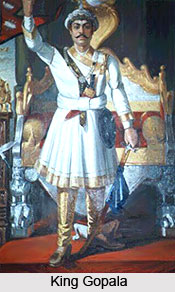 Gopala came to power in 750 AD in Gaur by democratic election as per evidence furnished by Tibetan scholar Taranatha. After the death of famous Gauda ruler Sasanka, a state of anarchy and confusion prevailed in Bengal. Unable to bring situation under control the various independent chieftains of Bengal selected a person named Gopala to put an end to this wretched condition of Bengal. Gopala was a Kshatriya by caste and had proved his valour and capability as a successful leader prior to his election as king. His original kingdom was Banga or East Bengal, He was a devotee of Buddha but he pursued the policy of war and conquest to extend his empire.
Gopala came to power in 750 AD in Gaur by democratic election as per evidence furnished by Tibetan scholar Taranatha. After the death of famous Gauda ruler Sasanka, a state of anarchy and confusion prevailed in Bengal. Unable to bring situation under control the various independent chieftains of Bengal selected a person named Gopala to put an end to this wretched condition of Bengal. Gopala was a Kshatriya by caste and had proved his valour and capability as a successful leader prior to his election as king. His original kingdom was Banga or East Bengal, He was a devotee of Buddha but he pursued the policy of war and conquest to extend his empire.
Gopala was a leading military general and had made a mark as a great ruler. In the Khalimpur copper plate inscription it is stated that Gopala`s father Vapyata is described as a famous military chief of his time and his grandfather Dayita Vishnu is considered as a learned man. Details of Gopala`s career or anything regarding his military conquests are vague. Some inscriptions do generalize his rule and many victories are attributed to him. However the Pala records reiterate that Gopala had defeated Kamakaris. Though Tarantha refers to his domination of Magadha but this seems to be an improbability. It can be said that Gopala was the master of Bengal province and checked anarchic elements.
He is believed to have strengthened his hold on entire Bengal. His reign-period is not precisely known but is believed to have spanned 750 AD through 770 AD. His main achievement was bringing about peace in Bengal by removing the prevalent chaos. His consolidation helped his son Dharmapala to expand the empire further. Even after him the Pala rulers kept their faith in Buddhism though they fought against their rivals to safeguard and extend their empire. He had built famous Buddhist monastery at Otantapura according to Tarantha.
This article is a stub. You can enrich by adding more information to it. Send your Write Up to content@indianetzone.com



















